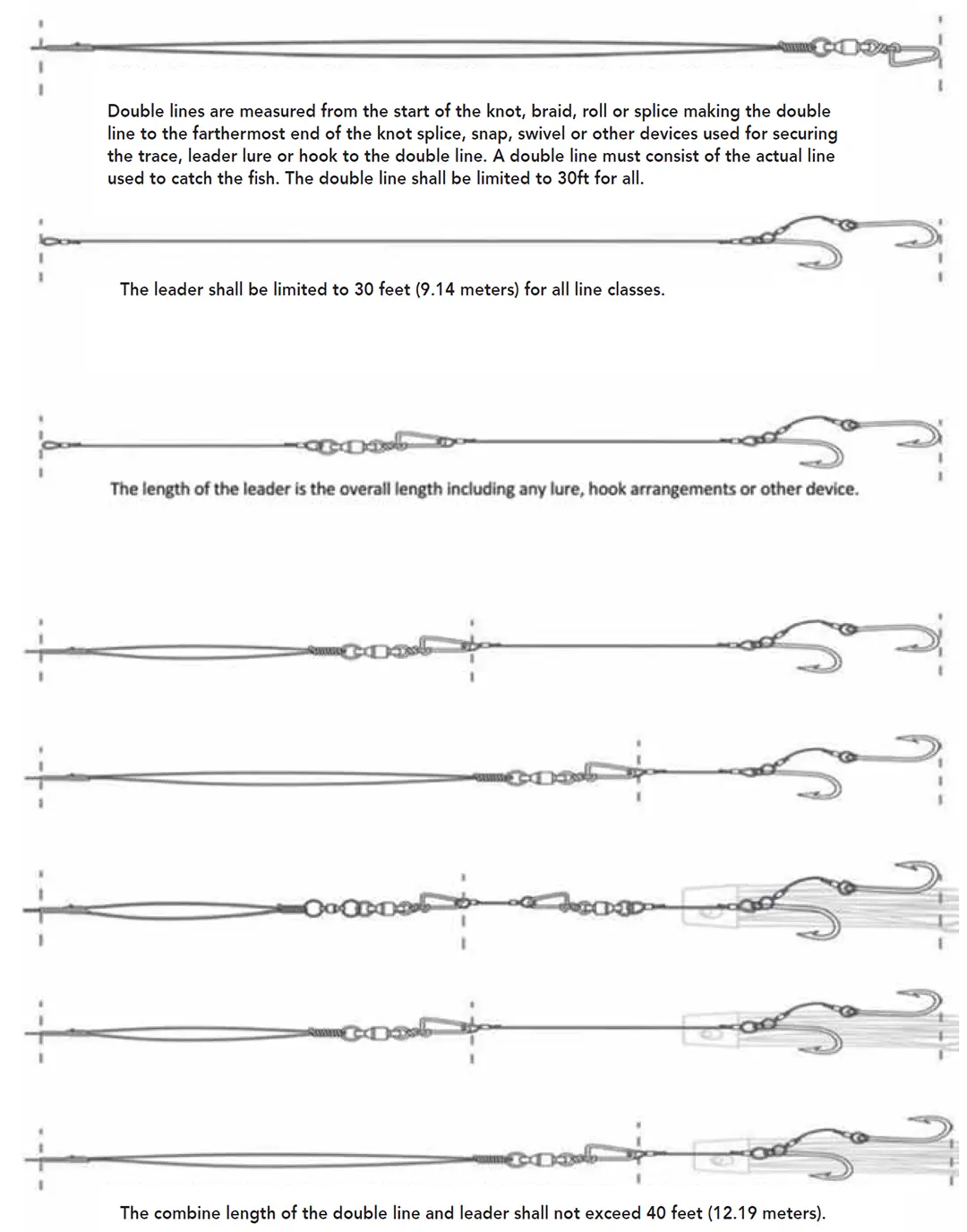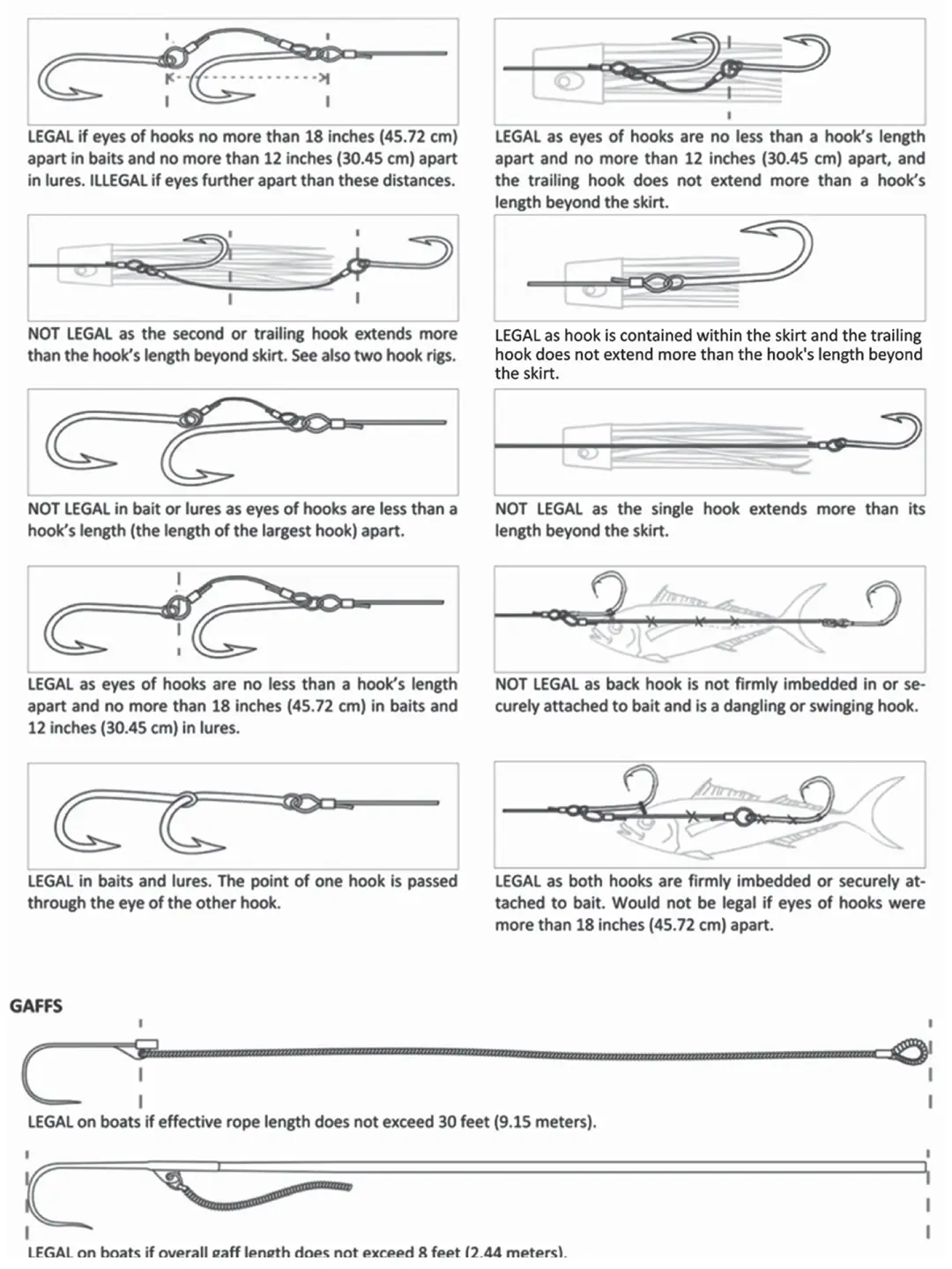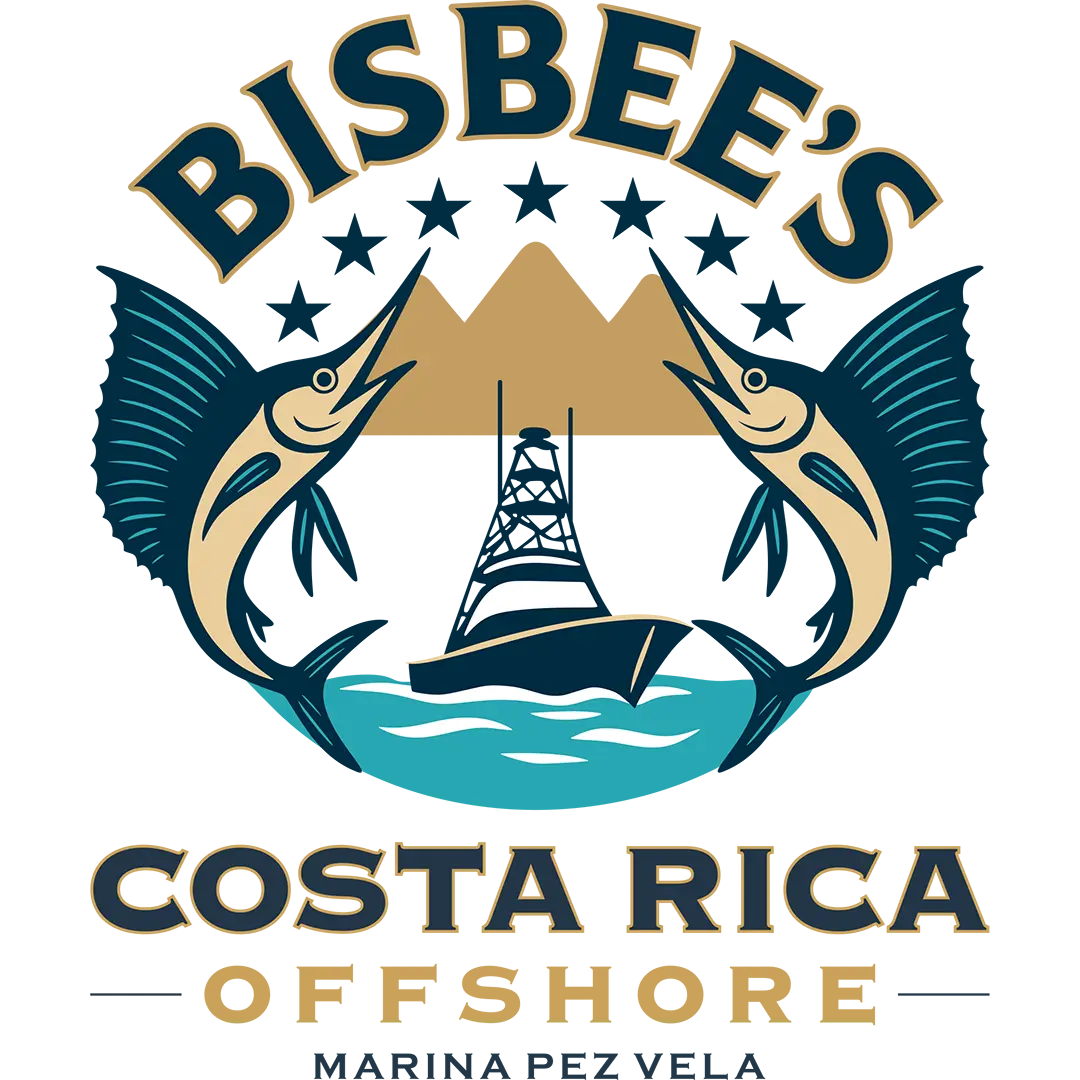Bisbee's Costa Rica Offshore - Equipment Rules
The official equipment regulations for the Costa Rica Offshore tournament. Please review these rules carefully to ensure compliance.
Equipment Rules (English)


FISHING LINE & BACKING:
- a) The term “Backing” pertains to any line on the reel that precedes the “Fishing Line” whether connected to the fishing line or not. The use of backing is permissible and does not have a maximum strength limit. The term “Fishing Line” pertains to the first 16.5 feet (5 meters) of line directly preceding the double line, leader, or hook. This section of fishing line must be comprised of a single, homogenous piece of line, and have a “Manufacturer’s Stated” maximum breaking strength of 130 lbs. or less. The catch shall be classified under the breaking strength of the Fishing Line and must be a minimum length of the stated 16.5 feet (5 meters).
- b) Dacron, monofilament, multifilament, and lead core multifilament lines may be used on either. Line by the trade name of Spectra is acceptable. Wire lines are prohibited.
Double Line:
The use of a double line is not required. If one is used, it must meet the following specifications:
- a) A double line must consist of the actual Fishing Line used to catch the fish.
- b) Double lines are measured from the start of the knot, braid, roll or splice making the double line to the farthermost end of the knot, splice, snap, swivel or other device used for securing the trace, leader, lure or hook to the double line.
- c) The double line on all classes of tackle shall be limited to 30 feet. The maximum combined length of the double line and leader is 40 feet.
Leader:
The use of a leader is not required. If one is used, it must meet the following specifications:
- a) The length of the leader is the overall length including any lure, hook arrangement or other device and is measured to the bend of the last hook.
- b) The leader must be connected to the line with a snap, knot, splice, swivel or other device.
- c) There are no regulations regarding the material or strength of the leader.
- d) The leader on all classes of tackle shall be limited to 30 feet. The combined length of the double line and leader shall be limited to 40 feet.
Rod:
- a) Rods must comply with sporting ethics and customs.
- b) The rod tip must be a minimum of 40 inches in length. The rod butt cannot exceed 27 inches.
- c) These measurements must be made from a point directly beneath the center of the reel. A curved butt is measured in a straight line.
Reel:
- a) Reels must comply with sporting ethics and customs.
- b) Power driven reels of any kind are prohibited. This includes motor, hydraulic, or electrically driven reels, and any device which gives the angler an unfair advantage.
- c) Ratchet handle reels are prohibited.
- d) Reels designed to be cranked with both hands at the same time are prohibited.
Hooks — Natural Bait (Live or Dead):
- a) Any hook used with natural bait, live or dead, must be a non-offset circle hook.
- b) No more than two single hooks may be used. Both must be firmly embedded in or securely attached to the bait. The eyes of the hooks must be no less than a hook’s length (the length of the largest hook used) apart and no more than 18 inches apart. The only exception is that the point of one hook may be passed through the eye of the other hook.
- c) A hook may not precede the bait, or bait/lure combo by more than one hook’s length.
- d) The use of a dangling/swinging hook is prohibited. No double or treble hooks.
Hooks — Artificial Lures:
- a) When using an artificial lure with a skirt or trailing material, no more than two single hooks may be attached to the line, leader, or trace. The hooks need not be attached separately. The eyes of the hooks must be no less than an overall hook’s length (the overall length of the largest hook used) apart and no more than 12 inches apart. The only exception is that the point of one hook may be passed through the eye of the other hook. The trailing hook may not extend more than a hook’s length beyond the skirt of the lure.
- b) A hook may not precede the lure or bait/lure combo by more than one hook’s length.
- c) The tournament recognizes products produced by Quick Rig Corporation under the trade name “Double Trouble Hooks” as acceptable tackle to be used in the tournament.
Drones:
Drones are not permitted to be flown during fishing hours. Special exceptions may be granted for promotional purposes only.
Other Equipment:
- a) Fighting chairs may not have any mechanically propelled devices that aid the angler in fighting.
- b) Gimbals must be free swinging. Gimbals that allow anglers to reduce strain or rest while fighting the fish are prohibited.
- c) Harnesses may be attached to the reel or rod, but not to the fighting chair. The harness may be replaced or adjusted by a person other than the angler.
- d) Rod belts or waist gimbals are permitted.
- e) Gaffs used to boat a fish must not exceed 8 feet in overall length. In using a flying or detachable gaff the rope may not exceed 30 feet. The gaff rope is measured from the point where it is secured to the detachable head to the other end. If a fixed head gaff is used, the same limitations shall apply and the gaff rope shall be measured from the same location on the gaff hook. Only a single hook is permitted on any gaff. Harpoon or lance attachments are prohibited. Tail ropes are limited to 30 feet.
- f) Entangling devices, with or without a hook, are prohibited and may not be used for any purpose including baiting, hooking or fighting or landing the fish.
- g) Nets may not be used to obtain a fish.
- h) Outriggers, downriggers, spreader bars and kites are permitted to be used, provided that the actual fishing line is attached to a snap or other release device, either directly or with some other material. The leader or double line may not be connected to the release mechanism either directly or with the use of a connecting device. Spreader bars are also acceptable when used strictly as a teaser.
- i) Daisy chains, birds, floats and similar devices may only be used if they do not unfairly hamper or inhibit the normal swimming or fighting ability of the fish, thereby giving the team an unfair advantage in fighting, releasing or boating the fish. Acceptability of this equipment will be determined by the Tournament Organizers on an individual, as needed basis.
- j) A safety line may be attached to the rod provided it does not in any way assist the angler in fighting the fish.
Reglas de Equipo (Español)


LÍNEA DE PESCA Y REFUERZO (BACKING):
- a) El término "Refuerzo" (Backing) se refiere a cualquier línea en el carrete que precede a la "Línea de Pesca", esté o no conectada a la línea de pesca. El uso de refuerzo es permisible y no tiene un límite máximo de resistencia. El término "Línea de Pesca" se refiere a los primeros 16.5 pies (5 metros) de línea directamente antes de la línea doble, el líder o el anzuelo. Esta sección de la línea de pesca debe estar compuesta por una sola pieza homogénea de línea y tener una resistencia máxima de rotura "declarada por el fabricante" de 130 lbs. o menos. La captura se clasificará según la resistencia de rotura de la Línea de Pesca y debe tener una longitud mínima de los 16.5 pies (5 metros) indicados.
- b) Se pueden usar líneas de Dacron, monofilamento, multifilamento y multifilamento con núcleo de plomo en cualquiera de los dos. La línea con el nombre comercial de Spectra es aceptable. Las líneas de alambre están prohibidas.
Línea Doble:
No se requiere el uso de una línea doble. Si se utiliza una, debe cumplir con las siguientes especificaciones:
- a) Una línea doble debe consistir en la Línea de Pesca real utilizada para capturar el pez.
- b) Las líneas dobles se miden desde el inicio del nudo, trenza, rollo o empalme que forma la línea doble hasta el extremo más alejado del nudo, empalme, broche, giratorio u otro dispositivo utilizado para asegurar el sedal, líder, señuelo o anzuelo a la línea doble.
- c) La línea doble en todas las clases de aparejos estará limitada a 30 pies. La longitud máxima combinada de la línea doble y el líder es de 40 pies.
Líder:
No se requiere el uso de un líder. Si se utiliza uno, debe cumplir con las siguientes especificaciones:
- a) La longitud del líder es la longitud total que incluye cualquier señuelo, arreglo de anzuelos u otro dispositivo y se mide hasta la curva del último anzuelo.
- b) El líder debe estar conectado a la línea con un broche, nudo, empalme, giratorio u otro dispositivo.
- c) No hay regulaciones sobre el material o la resistencia del líder.
- d) El líder en todas las clases de aparejos estará limitado a 30 pies. La longitud combinada de la línea doble y el líder estará limitada a 40 pies.
Caña:
- a) Las cañas deben cumplir con la ética y las costumbres deportivas.
- b) La punta de la caña debe tener una longitud mínima de 40 pulgadas. La culata de la caña no puede exceder las 27 pulgadas.
- c) Estas medidas deben tomarse desde un punto directamente debajo del centro del carrete. Una culata curva se mide en línea recta.
Carrete:
- a) Los carretes deben cumplir con la ética y las costumbres deportivas.
- b) Se prohíben los carretes motorizados de cualquier tipo. Esto incluye carretes accionados por motor, hidráulicos o eléctricos, y cualquier dispositivo que otorgue al pescador una ventaja injusta.
- c) Se prohíben los carretes con manivela de trinquete.
- d) Se prohíben los carretes diseñados para ser accionados con ambas manos al mismo tiempo.
Anzuelos — Carnada Natural (Viva o Muerta):
- a) Cualquier anzuelo utilizado con carnada natural, viva o muerta, debe ser un anzuelo circular no desalineado (non-offset).
- b) No se pueden usar más de dos anzuelos individuales. Ambos deben estar firmemente incrustados o sujetos de forma segura a la carnada. Los ojos de los anzuelos no deben estar separados por menos de la longitud de un anzuelo (la longitud del anzuelo más grande utilizado) ni por más de 18 pulgadas. La única excepción es que la punta de un anzuelo puede pasar por el ojo del otro.
- c) Un anzuelo no puede preceder a la carnada, o a la combinación de carnada/señuelo, por más de la longitud de un anzuelo.
- d) Se prohíbe el uso de un anzuelo colgante/oscilante. No se permiten anzuelos dobles o triples.
Anzuelos — Señuelos Artificiales:
- a) Al usar un señuelo artificial con falda o material de arrastre, no se pueden unir más de dos anzuelos individuales a la línea, líder o sedal. Los anzuelos no necesitan estar unidos por separado. Los ojos de los anzuelos no deben estar separados por menos de la longitud total de un anzuelo (la longitud total del anzuelo más grande utilizado) ni por más de 12 pulgadas. La única excepción es que la punta de un anzuelo puede pasar por el ojo del otro. El anzuelo de arrastre no puede extenderse más de la longitud de un anzuelo más allá de la falda del señuelo.
- b) Un anzuelo no puede preceder al señuelo o a la combinación de carnada/señuelo por más de la longitud de un anzuelo.
- c) El torneo reconoce los productos fabricados por Quick Rig Corporation bajo el nombre comercial "Double Trouble Hooks" como aparejos aceptables para ser utilizados en el torneo.
Drones:
No se permite el vuelo de drones durante las horas de pesca. Se pueden otorgar excepciones especiales únicamente con fines promocionales.
Otro Equipo:
- a) Las sillas de combate no pueden tener dispositivos de propulsión mecánica que ayuden al pescador en la pelea.
- b) Los cardanes (gimbals) deben tener movimiento libre. Se prohíben los cardanes que permiten a los pescadores reducir el esfuerzo o descansar mientras pelean con el pez.
- c) Se pueden sujetar arneses al carrete o a la caña, pero no a la silla de combate. El arnés puede ser reemplazado o ajustado por una persona que no sea el pescador.
- d) Se permiten cinturones de caña o cardanes de cintura.
- e) Los bicheros utilizados para embarcar un pez no deben exceder los 8 pies de longitud total. Al usar un bichero volador o desmontable, la cuerda no puede exceder los 30 pies. La cuerda del bichero se mide desde el punto donde está asegurada a la cabeza desmontable hasta el otro extremo. Si se usa un bichero de cabeza fija, se aplicarán las mismas limitaciones y la cuerda del bichero se medirá desde la misma ubicación en el gancho del bichero. Solo se permite un único gancho en cualquier bichero. Se prohíben los accesorios de arpón o lanza. Las cuerdas de cola están limitadas a 30 pies.
- f) Se prohíben los dispositivos de enredo, con o sin anzuelo, y no se pueden usar para ningún propósito, incluyendo cebar, enganchar, pelear o desembarcar el pez.
- g) No se pueden usar redes para obtener un pez.
- h) Se permite el uso de tangones (outriggers), profundizadores (downriggers), barras separadoras y cometas (kites), siempre que la línea de pesca real esté unida a un broche u otro dispositivo de liberación, ya sea directamente o con algún otro material. El líder o la línea doble no pueden conectarse al mecanismo de liberación, ni directamente ni con el uso de un dispositivo de conexión. Las barras separadoras también son aceptables cuando se usan estrictamente como señuelo de atracción (teaser).
- i) Se pueden usar cadenas de señuelos (daisy chains), pájaros, flotadores y dispositivos similares solo si no dificultan o inhiben injustamente la capacidad normal de nadar o luchar del pez, otorgando así al equipo una ventaja injusta en la lucha, liberación o embarque del pez. La aceptabilidad de este equipo será determinada por los Organizadores del Torneo de forma individual, según sea necesario.
- j) Se puede atar una línea de seguridad a la caña siempre que no ayude de ninguna manera al pescador en la lucha contra el pez.
